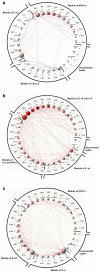Evidence of perturbations of the cytokine network in preterm labor
- PMID: 26232508
- PMCID: PMC4679519
- DOI: 10.1016/j.ajog.2015.07.037
Evidence of perturbations of the cytokine network in preterm labor
Abstract
Objective: Intraamniotic inflammation/infection is the only mechanism of disease with persuasive evidence of causality for spontaneous preterm labor/delivery. Previous studies about the behavior of cytokines in preterm labor have been largely based on the analysis of the behavior of each protein independently. Emerging evidence indicates that the study of biologic networks can provide insight into the pathobiology of disease and improve biomarker discovery. The goal of this study was to characterize the inflammatory-related protein network in the amniotic fluid of patients with preterm labor.
Study design: A retrospective cohort study was conducted that included women with singleton pregnancies who had spontaneous preterm labor and intact membranes (n = 135). These patients were classified according to the results of amniotic fluid culture, broad-range polymerase chain reaction coupled with electrospray ionization mass spectrometry, and amniotic fluid concentration of interleukin (IL)-6 into the following groups: (1) those without intraamniotic inflammation (n = 85), (2) those with microbial-associated intraamniotic inflammation (n = 15), and (3) those with intraamniotic inflammation without detectable bacteria (n = 35). Amniotic fluid concentrations of 33 inflammatory-related proteins were determined with the use of a multiplex bead array assay.
Results: Patients with preterm labor and intact membranes who had microbial-associated intraamniotic inflammation had a higher amniotic fluid inflammatory-related protein concentration correlation than those without intraamniotic inflammation (113 perturbed correlations). IL-1β, IL-6, macrophage inflammatory protein (MIP)-1α, and IL-1α were the most connected nodes (highest degree) in this differential correlation network (degrees of 20, 16, 12, and 12, respectively). Patients with sterile intraamniotic inflammation had correlation patterns of inflammatory-related proteins, both increased and decreased, when compared to those without intraamniotic inflammation (50 perturbed correlations). IL-1α, MIP-1α, and IL-1β were the most connected nodes in this differential correlation network (degrees of 12, 10, and 7, respectively). There were more coordinated inflammatory-related protein concentrations in the amniotic fluid of women with microbial-associated intraamniotic inflammation than in those with sterile intraamniotic inflammation (60 perturbed correlations), with IL-4 and IL-33 having the largest number of perturbed correlations (degrees of 15 and 13, respectively).
Conclusions: We report for the first time an analysis of the inflammatory-related protein network in spontaneous preterm labor. Patients with preterm labor and microbial-associated intraamniotic inflammation had more coordinated amniotic fluid inflammatory-related proteins than either those with sterile intraamniotic inflammation or those without intraamniotic inflammation. The correlations were also stronger in patients with sterile intraamniotic inflammation than in those without intraamniotic inflammation. The findings herein could be of value in the development of biomarkers of preterm labor.
Keywords: chemokine; chorioamnionitis; correlation network; interactome; intraamniotic infection; network analysis; sterile inflammation.
Published by Elsevier Inc.
Figures


References
-
- LIU L, JOHNSON HL, COUSENS S, PERIN J, SCOTT S, LAWN JE, et al. Global, regional, and national causes of child mortality: an updated systematic analysis for 2010 with time trends since 2000. Lancet. 2012;379(9832):2151–61. - PubMed
-
- BLENCOWE H, COUSENS S, OESTERGAARD MZ, CHOU D, MOLLER AB, NARWAL R, et al. National, regional, and worldwide estimates of preterm birth rates in the year 2010 with time trends since 1990 for selected countries: a systematic analysis and implications. Lancet. 2012;379(9832):2162–72. - PubMed
-
- MURRAY CJ, VOS T, LOZANO R, NAGHAVI M, FLAXMAN AD, MICHAUD C, et al. Disability-adjusted life years (DALYs) for 291 diseases and injuries in 21 regions, 1990-2010: a systematic analysis for the Global Burden of Disease Study 2010. Lancet. 2012;380(9859):2197–223. - PubMed
Publication types
MeSH terms
Substances
Grants and funding
LinkOut - more resources
Full Text Sources
Other Literature Sources
Medical

